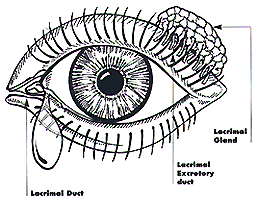
someone whose tear ducts don’t function.

 |
David explores the reasons we cry and talks with
someone whose tear ducts don’t function. |
 |
|---|
Tears flow from tear glands into your eyes through tiny tear ducts. The tear glands are located under your upper lids, and when stimulated, produce tears to form a thin film over your eyeballs. Every time you blink the film spreads over your eyes to keep them moist and free of dust and other irritants. Whether you are awake or asleep, happy or sad, this salty fluid is always flowing from the tear glands.
Besides protecting your eyes, the tear glands produce more fluid when your eyes are irritated. These extra tears are called reflex or irritant tears. And, when something makes you happy or sad, your tear glands will produce emotional tears. Used tears then drain down into two tiny openings on the brim of your upper and lower eyelids at the inner edge of your eyes, which lead to the nasolacrimal tear ducts next to the bridge of your nose. From there, they are channeled into your nasal cavity where they are swallowed or blown out with other nasal fluids. If there are too many tears, they will overflow your lower lid and run down your cheeks.
Some people have to help stimulate the production of natural tears. This disease is called Dry Eye Syndrome or Sjogren's Syndrome. People who have diseases like rheumatoid arthritis or lupus often have this condition. They must use artificial tears up to every 10 to 15 minutes, and apply other medications to their eyes before going to bed as part of the treatment to improve the condition of their eyes.
Lacrimal Gland--The glands which produce tears.
Reflex Tears--Also called irritant tears, these are extra tears which the tear glands produce when your eyes are irritated.
Emotional Tears--Extra tears that the tear glands produce in response to an emotional reaction.
Sjorgen's Syndrome--Also called Dry Eye Syndrome is caused when the tear glands are damaged and produce an inadequate amount of tears. This also affects saliva glands.
Find out how much your eyes work in a minute of blinking!
In this activity, you will determine the average number of times humans blink in one minute and the range of how the number of blinks per minute varies from one person to another.

1. Ask at least 10 people to help you gather information (data) on blinking. You will want to observe everyone under the same conditions. This is called controlling the variables. You should control for time, temperature and location.
2. Count how many times each person blinks in a minute. Enter your data in a chart.
3. Add the number of blinks from all the people you observed. Divide the sum by the total number of people observed to determine the average number of blinks.
4. To find the range, look for the person with the lowest number of blinks and the person with the most blinks per minute. The difference between the fewest and the most is called the range. For example, if George had five blinks and Juanita had 13, than the range is from five to 13.
1. How does your data compare to other studies done by your class?
2. What might happen if people blink twice as much as the average? If they cant blink at all?
3. Why do you blink? What might cause you to blink more often? Are these the same reasons your classmates or family have? How are their reasons different?
![]()
Should people try not to cry over onions? When peeled or cut, onions release a chemical that reacts with tears on the surface of your eyes. The chemical reaction produces sulfuric acid which irritates your eyes. Interview friends, family and neighbors to see what methods they use to keep from crying. Do they cry or try not to cry when they peel or slice onions? Experiment with other vegetables and fruits to determine if peeling, slicing, or chopping any of them makes you cry.
![]()
Most animals that live in air produce tears to keep their eyes moist. Many have eyelids and lashes that also help protect their eyes. Read about different animals like turtles, owls and snakes and find at least three that do not have eyelids. How do they protect their eyes?
![]()
The act of shedding tears is referred to as "weeping" or "crying."
![]()
The salt in tears acts as an antiseptic and prevents eye infections. Read the labels on eye care products at home, the grocery story, or the drug store. Do any of them contain salt solutions or list saline or sodium chloride as an ingredient? Find out what is in artificial tears, contact lens supplies, and eye wash solutions.
Tapes of this episode of Newton's Apple and others are available
from GPN for only $24.95.
Please call 1-800-228-4630.
For information on other Newton's Apple resources for home and school,
please call 1-800-588-NEWTON!
WE ENCOURAGE DUPLICATION FOR EDUCATIONAL USE!

 Newton's Apple is a production of KTCA Twin Cities Public Television. Made
possible by a grant from 3M.
Newton's Apple is a production of KTCA Twin Cities Public Television. Made
possible by a grant from 3M.
Educational materials developed with the National Science Teachers Association.